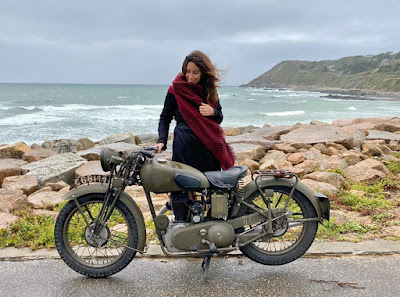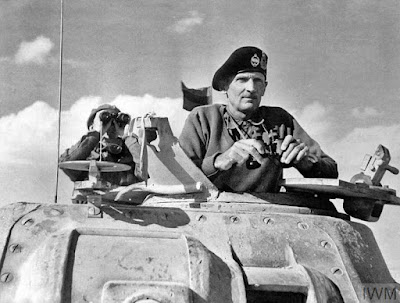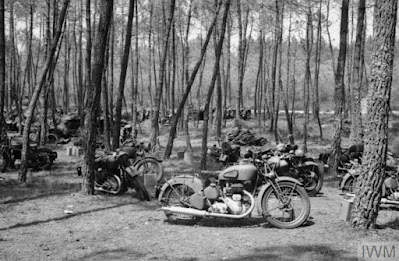 |
| Lt. Geoffrey Keating posed with Royal Enfield motorcycle in 1940. (Imperial War Museums Collections F 4776) |
A Royal Enfield military motorcycle, lost in the British Army's evacuation of France in 1940, and probably hidden under false documents and civilian paint after that, is found, rescued and restored.
Incredibly it's the very motorcycle in a wartime photo of it in khaki paint, posed with the combat photographer who may have used it to document the BEF's final days in France.
In the photo from 1940 the Royal Enfield's front wheel is turned, as if to show off its registration number. It's almost as if the photo is a message across 80 years: "Find me!"
The Royal Enfield is a WD/C, a side-valve, single-cylinder motorcycle probably sent to France with the British Expeditionary Force as a utility vehicle. Jan Vandevelde, a student of Royal Enfield military motorcycles, discovered it in France, where it was being incorrectly restored as a pre-war Royal Enfield.
Before that it had been used by a priest, somehow picking up a variety of incorrect parts from other makes and being described as an older motorcycle, perhaps to create a false history for it.
 |
| As originally found, the Royal Enfield had many non-original parts |
Jan has found other Royal Enfield WD motorcycles, and owns one similar to this one. He recognized the Royal Enfield as likely having served with the BEF, although its crankcase lacks an important identifying number.
Alex Schmidt of Holland, a collector of military vehicles, acquired the motorcycle in 2018 and began an exacting restoration to return the Royal Enfield to its military appearance.
If he was aware of the 1940 photograph of a Royal Enfield WD/C with Lt. Keating, he "had not given it much thought really...," he told me in an email.
"My mate Ron Pier in the UK, whom I had commissioned to do the restoration, as he had already done 10 Enfields or so, and he knew how everything had to be... I asked him not to sandblast the front number plate, as there was a thick layer of black paint on it, and could reveal something; so he said that I best take the plate home with me and sand it off myself.
"So I did!
"It took me a couple of afternoons to carefully wet and dry sand, and the number came from under the layers; the Frenchman had put the French registration on with sticky self-adhesive numbers, so that was easy to remove."
Alex even wrote on the Historic Military Vehicles Forum (HMVF) in March, 2020 "Hopefully I can retrieve the C number on the front number plate; there's something under the layer of high build primer."
He was correct. In April, 2020, he told the forum:
"OK, sorry, long time, no updates, but since I have the bike at home, I've done 91 miles, and it's a very nice bike to ride!! Have found out about the history as well, and did various technical jobs, I knew that needed to be done. But the icing on the cake was that the front number plate revealed that this is the bike that Lieutenant Keating was sitting on in June 1940!!!"
 |
| A friend poses with Alex Schmidt's restored Royal Enfield WD/C. (Photo courtesy Alex Schmidt) |
While the motorcycle's war record isn't known for sure, Lt. Keating's history is known, and it's a proud one.
When the Second World War broke out in September, 1939, just one Army photographer, Geoffrey J. Keating, accompanied the British Expeditionary Force to France.
Born and educated in London, of Irish parents, Lt. Keating was a 25-year-old former Fleet Street journalist now serving as an (unarmed) War Department photographer. By the time of the photo with the Royal Enfield he already had covered the British expedition in Norway in April, 1940.
Later, as a Captain, he would photograph the Long Range Desert Group crashing over a sand dune in a truck on March 27, 1941; Churchill in a pith helmet viewing positions at El Alamein on July 8, 1942; and cheery generals Eisenhower and Montgomery together in North Africa on March 31, 1943.
His is a photo of Monty in his beret, binoculars in hand, watching the beginning of the German retreat from El Alamein from the turret of his Grant tank, Nov. 5, 1942.
 |
| Gen. Bernard Montgomery views enemy retreat at El Alamein. (Geoffrey Keating photo, Imperial War Museums Collections E 18980) |
Wounded several times, Keating eventually was with the army in Sicily, Italy and Normandy and was present at the German surrender to Montgomery in Luneburg.
He rose in rank to Lieutenant Colonel, head of the Army Film and Photography Unit, 8th Army, adding the initials "MC" to his name with the award of the Military Cross for gallantry in Tobruk in 1940.
"Former Catholic Press photographer 'captures' Sicily town singlehanded," reads one wartime press clipping about him.
But on June 7, 1940, Keating was a lieutenant leaning on a Royal Enfield motorcycle near the Bresle River, and looking pretty composed, given the circumstances, which were alarming.
The evacuation of Dunkirk had ended on June 4, but thousands of British troops and British vehicles and weapons still remained in France. On June 5, German divisions had pushed back the depleted French and British divisions to the Bresle. This was the final German offensive, which defeated France.
From here on out, Keating would be covering a catastrophe.
He shot a photo captioned "Abandoned British Army motorcycles at Monce-en-Belin near Le Mans," dated June 13, 1940.
 |
| British Army motorcycles abandoned in the fall of France. (Geoffrey Keating Photo, Imperial War Museums Collections F 4841) |
Keating's photographs typically show things in good military order, soldiers calmly getting on with business despite crisis. Perhaps that's just the way it was in the British Army, or perhaps it was his job as a War Department photographer to make sure everyone had his cap on.
But he also has photos of abandoned and burned lorries, and trucks being used to block roads on the outskirts of Cherbourg, dated June 13.
Dated that same day, he has a photo of British vehicles neatly lined up on a quay at Cherbourg for evacuation. The British would leave thousands of vehicles in the flight from France, but some equipment did get away from this port.
Then there is a photo from shipboard entitled "British and French troops on board ships leaving Cherbourg en route for Southampton," also marked June 13, 1940. This suggests how Keating escaped. He must have been on that ship to make the photo.
In the photo with the Royal Enfield, Keating is thought to be holding a light meter. Was the Royal Enfield his machine, or just a place to perch for a self-portrait using the camera's timer?
Perhaps he wanted to mark the roll of film (which would be processed by others) with his picture so it would be recognized as his work. Maybe he just wanted to use up the last shot on the roll so he could get the camera reloaded.
 |
| Alex Schmidt's restored Royal Enfield C68144. (Photo courtesy Alex Schmidt) |
 |
| Close-up clearly shows C68144. (Photo courtesy Alex Schmidt) |
 |
| "C68144" is even more clear on other side of plate. (Photo courtesy Alex Schmidt) |
Keating's wartime photos are in the Imperial War Museums collections and can be viewed at the website GJK Images.
In the years after the war he became head of public relations for British Petroleum, which meant travel to exotic locations and contact with international leaders, politicians, diplomats "and the like," according to one obituary.
"He made an unparalleled contribution to Anglo-Middle East relations at that time in history," the obituary states. His job included "special duties," and he "spoke fluent Arabic."
"Apparently he liked to be called an Irish adventurer; I would also call him an international man of mystery!" daughter Rima said of him. He died in 1981, at only age 66, at home in London.
Looking at the 1940 photo I think Keating had a connection to that Royal Enfield, even an affection for it. Maybe it had just been issued to him and he was proud of his new ride. Or perhaps he was moving on as the enemy approached, and the photo was made to remember the one he left behind.
Alex is in contact with Keating's daughter Rima, and hopes to fill in more details. Perhaps she will remember hearing her father tell a story about a little motorcycle in the great war.
Photos in the Imperial War Museum Collections show that Keating shot pictures in France as early as September, 1939, the start of the war. But he left to cover the Norwegian campaign in April, 1940. He was in Norway as late as April 30, 1940, when he shot a photo of HMS Bittern ablaze after an attack by Stuka dive bombers.
He is definitely back in France by June 6-8, 1940, as he has a photo captioned "men of the 7th Argyll and Sutherland Highlanders, 51st Highland Division, holding a position in the River Bresle area, 6-8 June, 1940."
The Highlander's Stag Head insignia is seen on the fender of the truck in the background of the photo of Lt. Keating and the Royal Enfield motorcycle.
A photo of an exhausted soldier sleeping on board the MV Royal Sovereign en route to Southampton, in the evacuation from Cherbourg, is dated June 13, again suggesting that is the date Keating himself escaped France.
The fact that so many of his photos are dated June 13 might suggest that the date was arbitrarily applied when all his film was processed and printed on his return to England. Or, perhaps, he simply shot every interesting subject he could find on that, his last day in France, since there was no longer any need to hoard his supply.
I first learned of Lt. Keating and the recovery of his motorcycle from Andreas Papadakis on the Royal Enfield Owners Club-International-Greek Branch Facebook page. Always something interesting there!
































Or maybe the situation was so bad that he wanted to have a picture of himself with something that gave him joy in case he didn't make it out alive. He may have thought that if the photo survived and he didn't it may have gone to a loved one as a memory of him in a happy place. The beauty of the war photographer is that he allows even those who don't make it out alive to live on for ever in his photos!
ReplyDeleteVery well said.
Deletefantastic story!
ReplyDeleteGreat, great story! Many thanks for posting this. Wonderful that the bike could be restored and ridden again. As much as the bikes are at the center of our interest, it often comes down to the stories about their past and the people who owned and rode them. I'd never heard of Geoffrey Keating before, but I've certainly seen some of his photos over the years. It'd be great to see an exhibition of his work somewhere.
ReplyDeleteLooking at the Imperia War Museums website it is amazing how many of his photos are the ones we see over and over in documentaries and books. He was there.
DeleteDear all, Thank you David Blasco for posting this.It is so wonderful that my father's moterbike has been found & restored.Amazing that the photo of him on the bike that the numberplate was turned to view as you mention.
ReplyDeleteHuge thanks Jan vanderville,Ron Pier and Alex Schmidt for making it all possible,it looks fabulous & i hope one day to see it up close. So proud of my father he was an a 2WW hero of the highest caliber. His photographic archive is i believe the largest of the 2WW in Europe.And he was unarmed. (I hope he will be recognised by the British establishment one day.)
I have another (original framed) photograph of him on that moterbike with his military hat on, but the numberplate is not in view.)
All the best , Rima.A.Keating.
Rima, if you wish, I would be happy to add the photo you have to this story, if you will email it to david@royalenfields.com It does not have to be a high resolution image. You could copy it with your phone. Perhaps you could send a photograph of yourself holding his photo? That would be very appropriate for this article, I think. All best.
Deleteyes David my father was indeed there and captured the 2WW in photographs and film. Thank you all for this wonderful story. Rima
ReplyDeleteRima, thank you so much for your kind comments. I was very pleased to discover you father's fascinating history as I researched.
Delete